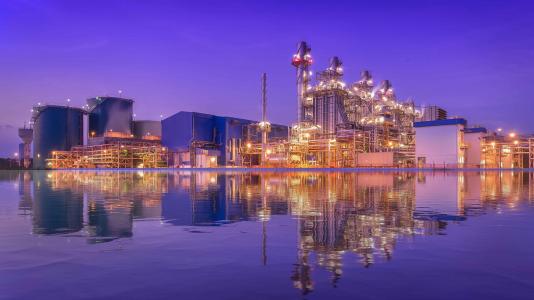
Every year, the oil and gas sector flares over 200 billion cubic meters of natural gas into the atmosphere. This waste product totals more than the amount of gas imported annually by France and Germany combined.
Natural gas is composed mostly of methane, a potent greenhouse gas 84 times more powerful than carbon dioxide (CO2) at trapping heat. Eliminating this one source of pollution can have a profound positive impact on the climate.
The U.S. Department of Energy’s (DOE’s) Argonne National Laboratory is working with M2X Energy on new technology that will turn wasted natural gas into valuable syngas. Syngas is a mixture of hydrogen and carbon monoxide that can be used to make methanol, a low-carbon liquid fuel. Everyday products including plastics, engineered lumber, and synthetic fibers are made from methanol.
The Argonne-M2X collaboration seeks to maximize production by understanding the complex chemistry and physics inside the gas-to-methanol engine. The technology can eliminate the need for gas flares if successful. M2X’s plan to install 10,000 of their engines by 2030 could reduce greenhouse gas emissions from the oil and gas sector by the equivalent of 43 million metric tons of CO2 per year.
Thanks to a grant from the DOE’s High-Performance Computing for Energy Innovation (HPC4EI) program, M2X has access to Argonne’s computing resources and research expertise. The Argonne team is helping the company develop models and run them on the lab’s supercomputers.
“At Argonne, we are developing a digital twin of M2X’s engine reformer system. We can use that digital twin to run the engine virtually under many different operating conditions. This way we can figure out the best strategy to run the system to maximize productivity,” said Joohan Kim. As a research scientist in the Multi-Physics Engine Computation Group of Argonne’s Transportation and Power Systems division, Kim develops computer-generated models and simulation tools to predict and analyze fluid flow in propulsion and power systems, such as internal combustion engines. Kim’s research typically focuses on minimizing fuel consumption and reducing harmful emissions while delivering power efficiently. This time, instead of figuring out how to use less fuel, Kim will be leading the effort to determine how the system should run to convert as much of that fuel into syngas as possible.
The computing power needed to run these complex simulations often goes beyond the capabilities of companies like M2X. By working with a national laboratory like Argonne, companies can save considerable time and expense on prototype manufacturing and real-world testing, lessening the risk of their financial investment.
Argonne researchers have in-depth knowledge of internal combustion engines and vast experience in modeling them, along with access to a combination of high performance computing power and computer science expertise found nowhere else. The project will take advantage of the computing resources available at the Argonne Leadership Computing Facility (ALCF), a DOE Office of Science user facility. Argonne’s team will use the powerful Theta supercomputer to run hundreds of detailed simulations to investigate what is happening inside M2X’s engine under various scenarios. M2X researchers can then compare simulation data to physical test results, optimizing the engine design and operating parameters. Ultimately, this will help M2X rapidly accelerate the time it takes to get their product to market.
“The expertise and computational tools at Argonne will provide a window into the engine cylinder, allowing us to understand and optimize the chemical and physical transformations happening inside. We’re thrilled to partner with the talented staff at Argonne on our mission to reduce flaring and decarbonize chemical manufacturing by re-purposing commercial piston engines as chemical reactors,” said Paul Yelvington, M2X Chief Science Officer.
By helping M2X achieve their goal of converting natural gas that would otherwise be flared into economically viable, sustainable, and valuable chemical products, Argonne can make a low-carbon future more achievable.
“Addressing decarbonization is a key priority for the energy industry right now. With this project, we can leverage our internal combustion engine modeling expertise and also enhance our impact on the real-world decarbonization process, and we will do so by studying the extremes of what an engine can do,” said Kim.
This project is one of the many ways Argonne is working with industry to support their decarbonization goals. “The HPC4EI program is a fantastic opportunity for national laboratories to not only use their expertise, but also their computational facilities, to help companies realize their goals,” said Riccardo Scarcelli, the leader of the Multi-Physics Engine Computations group at Argonne. “This program helps us understand the real needs of industry. Not only does this help to inform future lines of research, it helps us in future collaborations with industry.”
Scarcelli notes that the HPC4EI program has allowed Argonne scientists to interact with new partners, companies, and industries, and that many long and successful corporate partnerships were started through this program.
This research was made possible with a grant from the DOE’s High Performance Computing for Energy Innovation (HPC4EI) program. HPC4EI is the umbrella initiative for the High Performance Computing for Manufacturing (HPC4Mfg) Program and High Performance Computing for Materials (HPC4Mtls) Program. HPC4EI is funded by the DOE’s Office of Energy Efficiency and Renewable Energy’s (EERE) Advanced Materials and Manufacturing Technologies Office (AMMTO) and Office of Fossil Energy and Carbon Management (FECM). To learn how your company might work with Argonne through the HPC4EI program, contact partners@anl.gov.